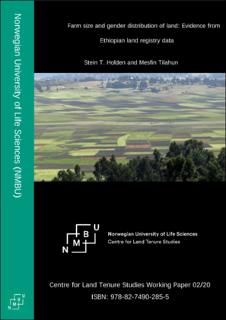Resource information
Land is an essential asset for the livelihood and welfare of rural households in agriculture-based rural economies. This study utilizes land registry data from the First and Second Stage Land Registration (FSLR and SSLR) Reforms that took place in 1998 and 2016 in Tigray region of Ethiopia, the first region in Ethiopia to implement land registration and certification. Second Stage Land Registration and Certification (SSLR&C) provided households with parcel-based certificates with names of all holders. We assess the changes in farm sizes and gender distribution of land using mean and median sizes, Gini coefficients, and cumulative distribution graphs. The SSLR data facilitate detailed gender-disaggregated analysis after aggregating parcel data by gender to household level and categorizing households in male- and female-headed households. The data came from 11 municipalities in four districts, covering 78,700 parcels, a total area of about 30,000 ha, allocated to 31,150 households (SSLR). Average farm size declined from 1.15 to 0.90 ha and median farm size from 0.88 to 0.63 ha from 1998 to 2016. The Gini coefficient for land per capita increased from 0.42 in 1998 to 0.57 in 2016. The female landholding share for this land was as high as 48.8% in 2016. Compared to female-headed households, male-headed households had on average 27% and 35% more land per household in 1998 and 2016. The study demonstrates the relevance of land registry data for the monitoring of farm sizes and gender distribution of land and the findings are of relevance for the Sustainable Development Goal 1.4.

